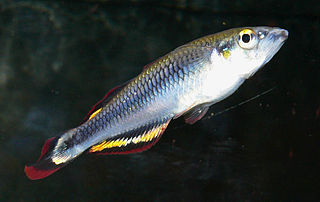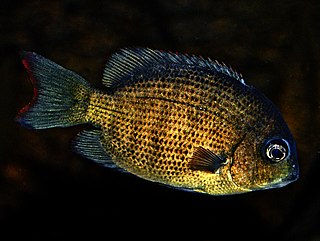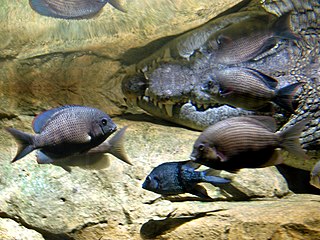
Bedotia is a genus of the family Bedotiidae of fishes endemic to Madagascar.

Bedotiinae are a subfamily of the rainbowfish family Melanotaeniidae, commonly known as the Madagascar rainbowfish, Madagascan rainbowfish, or Malagasy rainbowfish due to their endemism to Madagascar. It includes two genera, Bedotia and Rheocles.
Rheocles is a genus of Madagascar rainbowfish. Rheocles has a restricted distribution, being found only in certain forested freshwater habitats in the central and eastern highlands of Madagascar including the Nosivolo River. The genus appears to feed almost exclusively on allochthonous material, primarily insects falling onto the water surface.

Paretroplus is a genus of fishes in the cichlid family, all of which are endemic to lakes and rivers of Madagascar. The vast majority are threatened and restricted to the northwestern part of the island. Only P. polyactis is found in the southern half of Madagascar and only P. polyactis and P. gymnopreopercularis are found in eastern drainages. Most are restricted to freshwater, but at least P. polyactis and P. maromandia can also be seen in brackish habitats.

Paretroplus menarambo is a species of cichlid fish.

Ptychochromis grandidieri is a species of fish in the family Cichlidae endemic to river basins along a large part of the eastern coast of Madagascar, although it has been recorded as far as 100 km (62 mi) inland. Uniquely in the genus Ptychochromis, this species also occurs in brackish water. It reaches 35cm in standard length. It shares a large part of its range with a cichlid from another genus, Paretroplus polyactis. The specific name honours Alfred Grandidier (1836-1921), the French naturalist and explorer who, with Henri Joseph Léon Humblot (1852-1914), collected the type.

Ptychochromis is a genus of cichlids endemic to rivers and lakes in Madagascar. One species can also be seen in brackish water. Most species in this genus are threatened, and P. onilahy is probably extinct. Most reach a length of 15 to 20 cm, but P. insolitus reaches 25 cm (10 in), while P. grandidieri and P. oligacanthus reach 35 cm (14 in) and 20 cm (8 in) respectively. The largest species was P. onilahy which may have reached as much as 45 cm (18 in) if reports of fishermen are to be believed.
Ptychochromis inornatus is an endangered species of cichlid endemic to the Ankofia River basin and its tributaries in the eastern part of the Mahajanga Province in Madagascar. It is threatened by habitat loss. It reaches 12.2 cm (4.8 in) in standard length.

Ptychochromis oligacanthus is a species of cichlid endemic in fresh water habitats in the western part of the Antsiranana Province in Madagascar. The population on the island of Nosy Be appears to be stable, but the mainland populations are threatened by habitat loss. It reaches a length of 25 centimetres (9.8 in) TL.
Ptychochromis loisellei is a species of cichlid from the Mahanara River basin north of Sambava in northeastern Madagascar. It remains common within its small range, but it is threatened by habitat loss and introduced species. It reaches about 11.9 centimetres (4.7 in). The similar named Paretroplus loisellei is also restricted to the Mahanara River basin. The specific name honours Paul V. Loiselle, emeritus Curator of Freshwater Fishes at the New York Aquarium and a researcher in, and campaigner for the conservation of, the freshwater fish of Madagascar.
Ptychochromis curvidens is an endangered species of fish in the cichlid family. It is endemic to a few rivers that flow west from Montagne d'Ambre in far northern Madagascar. It is threatened by habitat loss and introduced species. It reaches about 14.7 cm (5.8 in) in standard length.

Ptychochromoides is a genus of cichlids endemic to Madagascar. Of the three described species, two are critically endangered and one was considered extinct until rediscovered in late 2010.
Katria is a genus of freshwater fish in the cichlid family. It contains the single species Katria katria, a vulnerable species from the Mangoro and Nosivolo Rivers in east-central Madagascar, that was formerly included in the genus Ptychochromoides. The only other monotypic cichlid genus in Madagascar is Oxylapia, and it is restricted to the same region as Katria. In 2010, the Nosivolo River was designated as a Ramsar Site. The Katria reaches about 13 centimetres (5.1 in) in length.
Sauvagella madagascariensis is a small species of fish in the family Clupeidae. It is endemic to fresh and brackish water in rivers of eastern Madagascar, ranging from the Mananjary to the Mananara. This relatively slender fish reaches a length of 6.6 cm (2.6 in), and is usually pale yellow with silvery on the flanks and head, though some larger individuals are more strongly coloured with orange or red.
Sauvagella robusta is a small species of fish in the family Clupeidae. It is endemic to the Amboaboa and Mangarahara River Basins in northern Madagascar. This relatively slender fish reaches a length of 6.8 cm (2.7 in), and is overall pale yellowish with silvery on the lower parts. Its current conservation status is unclear, but the cichlid Ptychochromis insolitus, which is highly threatened from habitat loss, is native to the same region. Sauvagella robusta is known to survive at least in Lake Tseny.
The two-finned round herring is a species of fish in the family Clupeidae. It is endemic to Madagascar. Its natural habitat is rivers. It is the only species in its genus.

Ptychochromis insolitus, also known as the Mangarahara cichlid or joba mena, is a species of cichlid endemic to certain river systems in northern Madagascar. This critically endangered fish is threatened by habitat loss and competition from introduced species; after the last-known female was killed during a breeding attempt, its conservation received significant international attention as London Zoo launched a media campaign to identify any remaining individuals. A remnant population was discovered by aquaculture entrepreneur Guy Tam Hyock in 2013, and breeding programs in Madagascar and at Toronto Zoo have resulted in thousands of successful hatchlings.
Paretroplus loisellei is a vulnerable species of cichlid fish from the Mahanara River basin north of Sambava in northeastern Madagascar. Until its scientific description in 2011, this population was usually referred to as Paretroplus sp. nov. "Ventitry" or included in P. damii, which it resembles. It reaches about 15 centimetres (5.9 in) in length, and is threatened by habitat loss and introduced species. The similar named Ptychochromis loisellei is also restricted to the Mahanara River basin. The specific name honours Paul V. Loiselle, Emeritus Curator of Freshwater Fishes at the New York Aquarium and a researcher in, and campaigner for the conservation of, the freshwater fish of Madagascar.
Melanie Lisa Jane Stiassny is the Axelrod Research Curator of Ichthyology at the American Museum of Natural History. Her research interests focus on freshwater biodiversity documentation and systematic ichthyology in the Old World tropics, including tropical Africa and Madagascar. She has published broadly on the biogeography conservation and systematics of teleosts.

Coptodon is a genus of cichlids native to fresh, brackish and coastal marine waters in Africa with C. zillii also found in the Middle East. It is the only genus in the tribe Coptodonini. Formerly included in Tilapia, this genus and tribe was separated in 2013. Despite the change in genus, Coptodon spp. are still referred to by the common name tilapia. Several species are important in local fisheries and a few are aquacultured.








